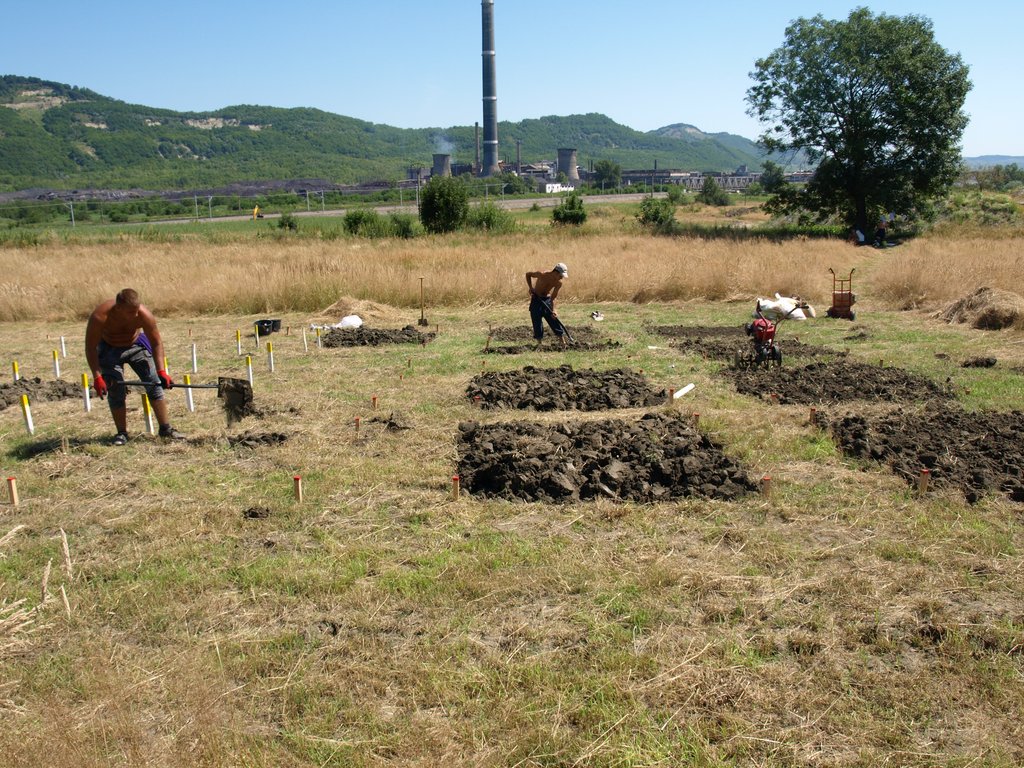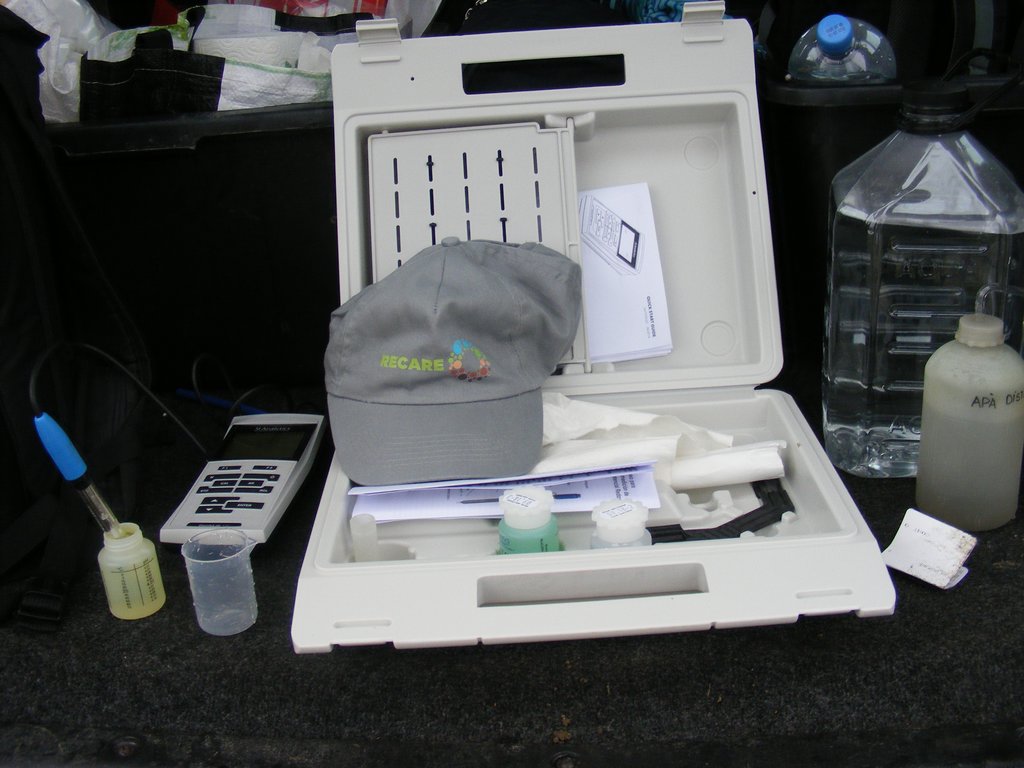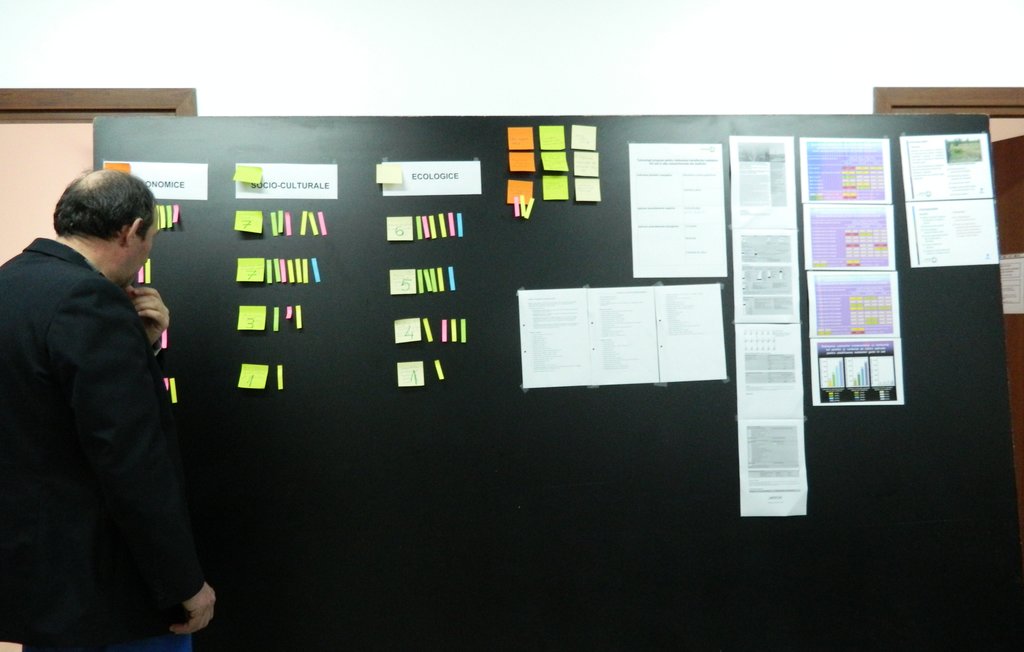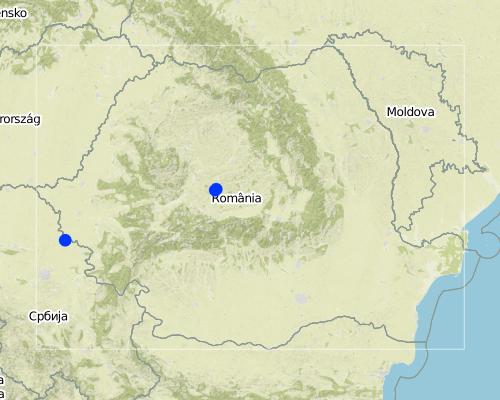Information and awareness raising for safe use of metal contaminated land [Romania]
- Creation:
- Update:
- Compiler: Nicoleta Vrinceanu
- Editor: –
- Reviewer: GWJ van Lynden
Cresterea gradului de constientizare si informarea populatiei in scopul utilizarii in siguranta a terenurilor din zonele contaminate cu metale grele
approaches_570 - Romania
View sections
Expand all Collapse all1. General information
1.2 Contact details of resource persons and institutions involved in the assessment and documentation of the Approach
1.3 Conditions regarding the use of data documented through WOCAT
When were the data compiled (in the field)?
02/03/2015
The compiler and key resource person(s) accept the conditions regarding the use of data documented through WOCAT:
Ja
2. Description of the SLM Approach
2.1 Short description of the Approach
The aim of this Aprroach is to increase the awareness about the risk related to agricultural use of contaminated land and to present the appropriate technologies for sustainable use of contaminated land in order to reduce the transfer of contaminants into the food chain. The implementation of appropriate SLM will improve the soil and crop quality with positive effects on the quality of life for local community from contaminated area.
2.2 Detailed description of the Approach
Detailed description of the Approach:
The Case Study area is located in Sibiu County, around the most important factory for processing of non-ferrous ores – Copsa Mica. The main environmental damages in the area Copşa Mică (Romania) are caused by ore processing and this town was classified as an environmental disaster area. The main pollutants identified in this area were cadmium, copper, lead and zinc. According to data from LPIS provided by Sibiu County Center of Agency for Payments and Intervention in Agriculture (2012) the arable land represents 60.4% from total area (2818.6ha) being located mainly in bottomland. Grassland represents 34.9% from total area, that means 1627.3 ha. Orchards and vineyards represent a very small proportion from total cultivated area, only 2.3% (106 ha) and 2.4% (110.3 ha).
Large scale migration from urban to rural areas (village surrounding the Copsa Mica) took place after reducing the activities of industrial platform. In villages located in polluted area there are many small landowners. The lands are used as agricultural land and the products are used for own consumption. Also, due to both, low fertility of soil (as a result of contamination) and lack of financial resources, there are lands abandoned. The agricultural use of the land represents a risk for population health and also reduces the number of methods that could be used for remediation.
The aim of the approach was to increase the awareness about the risk related to agricultural use of contaminated land and to present the appropriate technologies for sustainable use of contaminated land in order to reduce the transfer of contaminants into the food chain. The implementation of appropriate SLM will improve the soil and crop quality with positive effects on the quality of life for local community from contaminated area.
During workshops stakeholders are informed about state of soil degradation from their area, about risk related to agricultural use of contaminated land. The researchers and SLM experts share their experience with land owners and land users related to sustainable measures for reducing the effects of soil contamination and together they select the measures to be tested. The production of biomass for non-food purpose has been tested as a potential solution to produce valuable biomass while remediating the soil. Immobilization of heavy metals in soil was agreed by the traditional land owners who want to keep the agricultural use for their land.
Land owners offer the plot for testing the new technology and researchers / SLM experts organised experimental field and presenting the results to land owners, local authority, farmers, students during information session (field day, workshop)
2.3 Photos of the Approach
General remarks regarding photos:
Activities for information and test the new technology selected by land users and experts
2.5 Country/ region/ locations where the Approach has been applied
Country:
Romania
Region/ State/ Province:
Sibiu county
Further specification of location:
Copsa Mica
Comments:
Both Copsa Mica and Axente Sever are located in highly contaminated area.
Map
×2.6 Dates of initiation and termination of the Approach
If precise year is not known, indicate approximate date when the Approach was initiated:
less than 10 years ago (recently)
2.7 Type of Approach
- project/ programme based
2.8 Main aims/ objectives of the Approach
The aim was to increase the awareness about the risk related to agricultural use of contaminated land and to present the appropriate technologies for sustainable use of contaminated land in order to reduce the transfer of contaminants into the food chain. The implementation of appropriate SLM will improve the soil and crop quality with positive effects on the quality of life for local community from contaminated area.
2.9 Conditions enabling or hindering implementation of the Technology/ Technologies applied under the Approach
social/ cultural/ religious norms and values
- hindering
The traditional farmers want to preserve the agricultural use of land (crop production and grazing). Growing biofuel crops would require changing the land use for a long period of time.
availability/ access to financial resources and services
- hindering
Lack of financial resources of the land users. The financial inputs for implementation are considered high even if there are subsidies for energy crops.
institutional setting
- hindering
There are no interest for SLM on contaminated lands
legal framework (land tenure, land and water use rights)
- hindering
Due to the large number of owners and the division of the land into small plots there are difficulties with respect to the application of appropriate SLM.
policies
- hindering
Although there are legal frameworks regarding pollution control there are no institutions responsible for the development and implementation of remediation measures. Also there are no clear legal descriptions of decision criteria for choosing the appropriate remediation actions.
knowledge about SLM, access to technical support
- hindering
Although there are known risks associated with soil contamination with heavy metals, landowners do not have enough information about SLM which could limit the transfer of metals into the food chain.
markets (to purchase inputs, sell products) and prices
- hindering
The energy crop market is not developed yet.
workload, availability of manpower
- enabling
3. Participation and roles of stakeholders involved
3.1 Stakeholders involved in the Approach and their roles
- local land users/ local communities
land users, local authority, farmers
They participate in information sessions and one land user offered a plot to test new technologies for immobilization of heavy metals in soil.
- researchers
Researchers - soil scientist, enviromental experts,
They share their experience in respect with risk related with agricultural use of land in contaminated area and appropriate SLM for limiting the transfer of heavy metals into food chain.
3.2 Involvement of local land users/ local communities in the different phases of the Approach
| Involvement of local land users/ local communities | Specify who was involved and describe activities | |
|---|---|---|
| initiation/ motivation | passive | Researchers organised information sessions (workshops and stakeholder meetings) for land owners, local authority, farmers, students. |
| planning | interactive | Researchers and SLM experts organised participatory sessions with land owners, local authority, farmers, students in order to select the appropriate SLM Technology to be tested. |
| implementation | interactive | Land owners offer the plot for testing the new technology and researchers and SLM experts organised experimental field and presenting the results to land owners, local authority, farmers, students during information session (field day, workshop) |
| monitoring/ evaluation | none | |
| Research | none |
3.3 Flow chart (if available)
Description:
NA
3.4 Decision-making on the selection of SLM Technology/ Technologies
Specify who decided on the selection of the Technology/ Technologies to be implemented:
- mainly land users, supported by SLM specialists
Explain:
Selection of appropriate SLM Technologies was made by land users, farmers and land owners suppoted by SLM specialists during participatory sessions.
Specify on what basis decisions were made:
- evaluation of well-documented SLM knowledge (evidence-based decision-making)
- research findings
- personal experience and opinions (undocumented)
4. Technical support, capacity building, and knowledge management
4.1 Capacity building/ training
Was training provided to land users/ other stakeholders?
Ja
Specify who was trained:
- land users
Form of training:
- farmer-to-farmer
- demonstration areas
- public meetings
Subjects covered:
Status of soil degradation by heavy metal contamination. Risk related to agricultural use of contaminated land. Measures for reducing the transfer of contaminants into food chain.
4.2 Advisory service
Do land users have access to an advisory service?
Ja
Specify whether advisory service is provided:
- on land users' fields
4.3 Institution strengthening (organizational development)
Have institutions been established or strengthened through the Approach?
- no
4.4 Monitoring and evaluation
Is monitoring and evaluation part of the Approach?
Ja
If yes, is this documentation intended to be used for monitoring and evaluation?
Ja
4.5 Research
Was research part of the Approach?
Ja
Specify topics:
- ecology
5. Financing and external material support
5.1 Annual budget for the SLM component of the Approach
If precise annual budget is not known, indicate range:
- 2,000-10,000
Comments (e.g. main sources of funding/ major donors):
Research projects funding from National Research Fund and EU projects
5.2 Financial/ material support provided to land users
Did land users receive financial/ material support for implementing the Technology/ Technologies?
Ja
If yes, specify type(s) of support, conditions, and provider(s):
Subsidies for energy crops
5.3 Subsidies for specific inputs (including labour)
- agricultural
| Specify which inputs were subsidised | To which extent | Specify subsidies |
|---|---|---|
| seeds | partly financed | 173 US$ / ha - spring 2015 |
5.4 Credit
Was credit provided under the Approach for SLM activities?
Nee
5.5 Other incentives or instruments
Were other incentives or instruments used to promote implementation of SLM Technologies?
Nee
6. Impact analysis and concluding statements
6.1 Impacts of the Approach
Did the Approach improve knowledge and capacities of land users to implement SLM?
- No
- Yes, little
- Yes, moderately
- Yes, greatly
Were highlighted risks of agricultural use of contaminated land and the possibilities of limiting the transfer of contaminants into the food chain by changing land use or by immobilizing metals in soil.
Did the Approach lead to employment, income opportunities?
- No
- Yes, little
- Yes, moderately
- Yes, greatly
Implementing the SLM could lead to high economic value of the crop (biomass fuel production, healthy crops, etc).
6.2 Main motivation of land users to implement SLM
- increased production
- increased profit(ability), improved cost-benefit-ratio
- payments/ subsidies
The farmers recieved the subsidiy for energy crops.
6.3 Sustainability of Approach activities
Can the land users sustain what has been implemented through the Approach (without external support)?
- no
If no or uncertain, specify and comment:
They need financial support to continue application of selected SLM.
6.4 Strengths/ advantages of the Approach
| Strengths/ advantages/ opportunities in the land user’s view |
|---|
| Receiving the knowledge tools to improve the quality of crops and offering the possibility to provide new products (from biofuel crops) on the market which increase the farm income. |
| Strengths/ advantages/ opportunities in the compiler’s or other key resource person’s view |
|---|
| Awareness raising about the risk related to agricultural use of contaminated land lead to increase the number of land users which want to implement appropriate SLM for contaminated land. |
6.5 Weaknesses/ disadvantages of the Approach and ways of overcoming them
| Weaknesses/ disadvantages/ risks in the land user’s view | How can they be overcome? |
|---|---|
|
Difficulties to continue the activities initiated without external financial input. |
Subsidies |
| Undeveloped energy crop market | Support for creating local or regional markets for energy crops |
| Weaknesses/ disadvantages/ risks in the compiler’s or other key resource person’s view | How can they be overcome? |
|---|---|
| Inadequate authorities' interest for SLM | The authorities have to provide help in order to meet the needs (support for poor land users) in order to implement SLM activities to change land uses or to adopt measures for reducing transfer of contaminants into the food chain. |
7. References and links
7.1 Methods/ sources of information
- field visits, field surveys
- interviews with land users
- compilation from reports and other existing documentation
7.2 References to available publications
Title, author, year, ISBN:
Nicoleta Vrinceanu, Motelica, D.M., Dumitru, M., Eugenia GAMENŢ, Calciu, I., Veronica Tanase, Mihaela Preda (2008) – Assessment of Some Inorganic Additives Used for In-Situ Remediation of Heavy Metals Polluted Soils, Abstract book of The 1st European Conference on Remediation of Soil, sediment and Groundwater – Biological, Chemical and Physical Technologies, 21–23 october 2008, Amsterdam, Olanda, p.173.
Title, author, year, ISBN:
Comănescu, l., Nedelea, A., Paisa, M., 2010. Soil pollution with heavy metals in the area of Copșa Mică town – Geographical considerations, Metalurgia International XV 4, 81-85.
Title, author, year, ISBN:
Lăcătușu, R., Lăcătușu, A.R., 2010. Evolution of heavy metals pollution from Copșa Mică. Scientific Papers, UASVM Bucharest, Series A, LIII, 85-92.
Title, author, year, ISBN:
Petronela-Bianca Pavel, Puschenreiter, M., Wenzel, W.W., Elena Diacu, Barbu, C.H., Aided phytostabilization using Miscanthus sinensis × giganteus on heavy metal-contaminated soils, Science of the Total Environment 479–480 (2014) 125–131
7.3 Links to relevant information which is available online
Title/ description:
Miscanthus giganteus - o solution for contaminated land
URL:
http://www.tribuna.ro/stiri/actualitate/miscanthus-plantat-la-cop-sa-mic-a-inc-a-din-2007-51036.html
Title/ description:
Miscanthus giganteus - the crops too expensive for romanian farmers
URL:
http://www.tribuna.ro/stiri/eveniment/culturile-de-miscanthus-prea-scumpe-pentru-agricultorii-sibieni-76070.html
Title/ description:
*** Annual Report of EPA Sibiu County. 2012. (in Romanian)
URL:
http://apmsb.anpm.ro/upload/62681_Raport%20anual%20privind%20monitorizarea%20PIGCA%20pentru%20anul%202011.pdf
Links and modules
Expand all Collapse allLinks
No links
Modules
No modules







